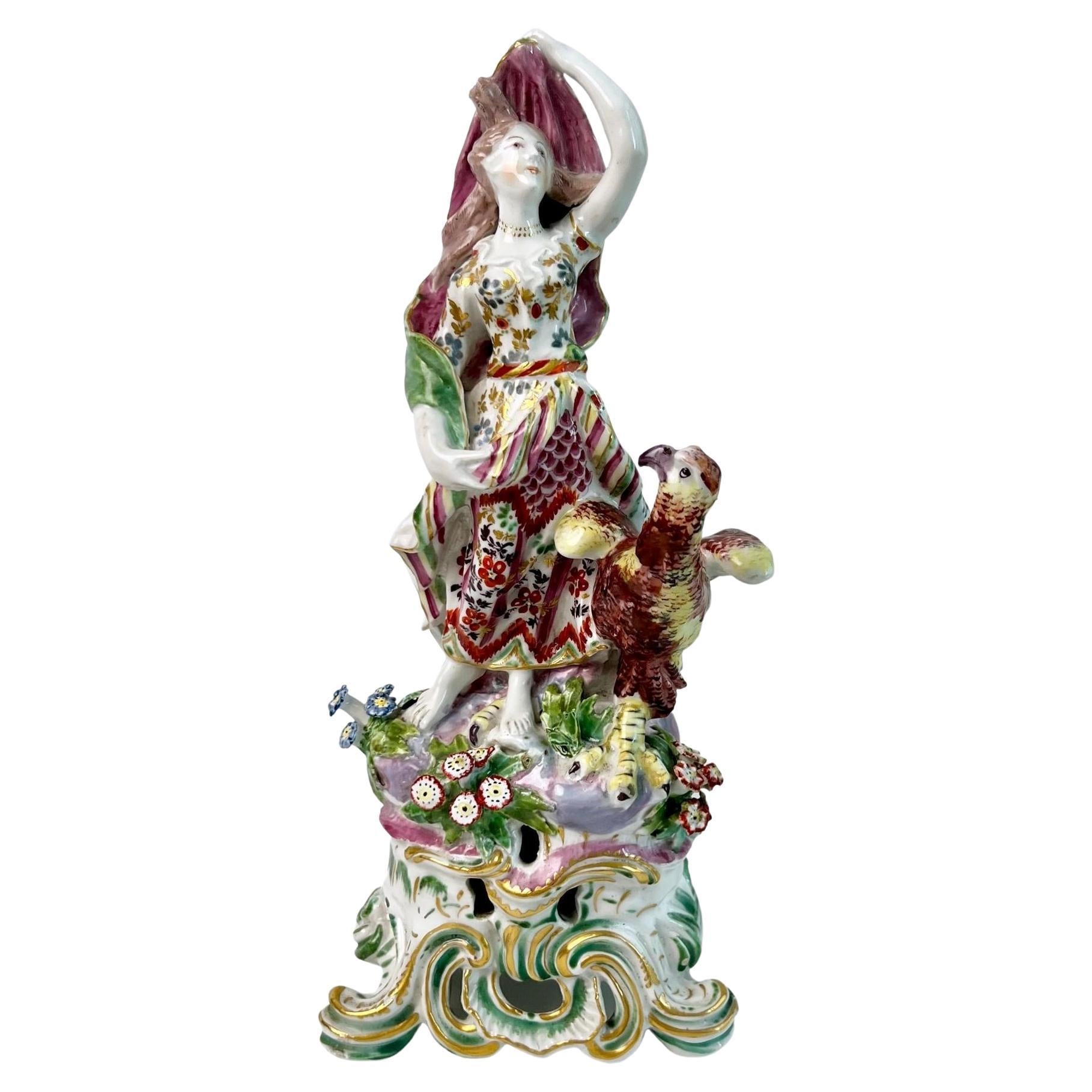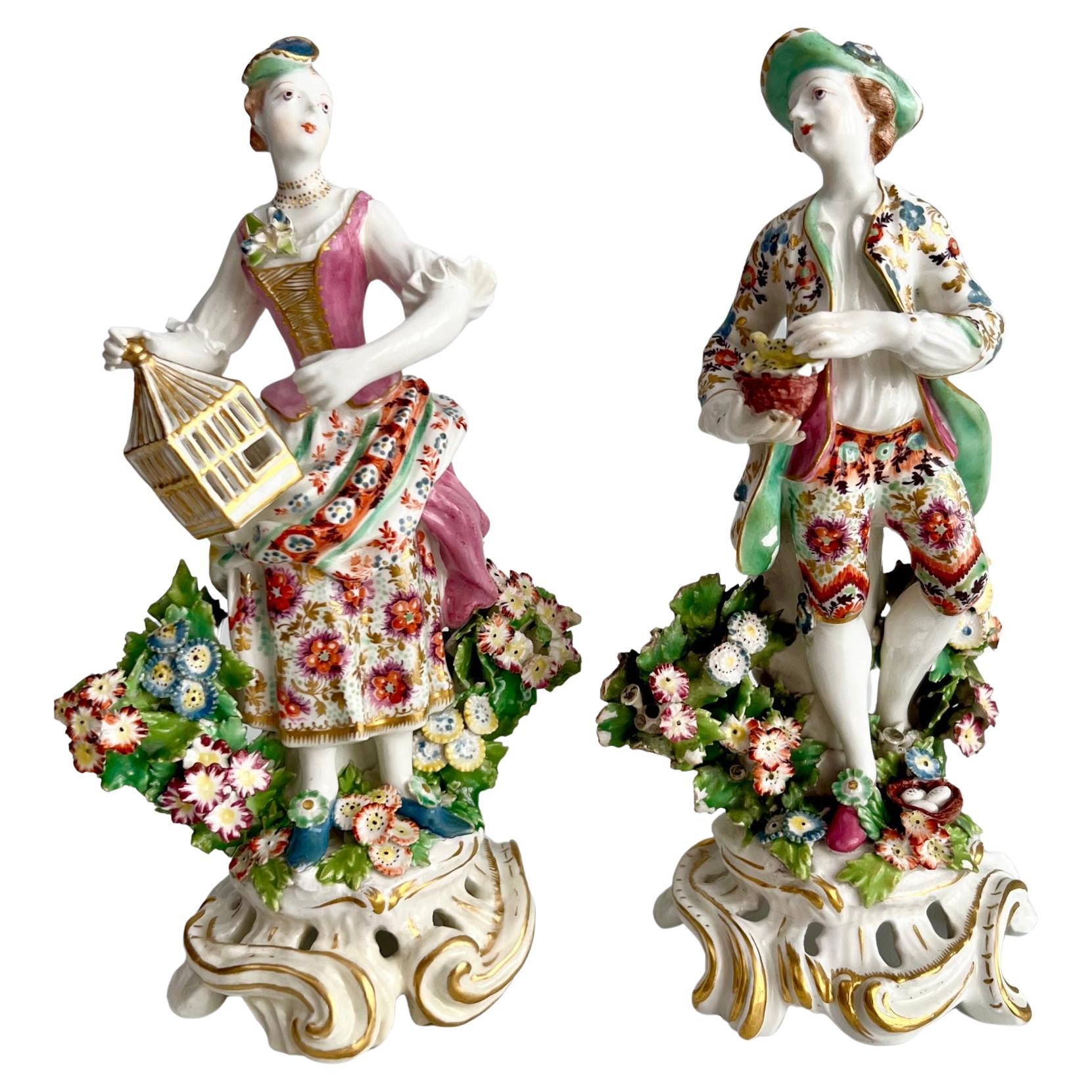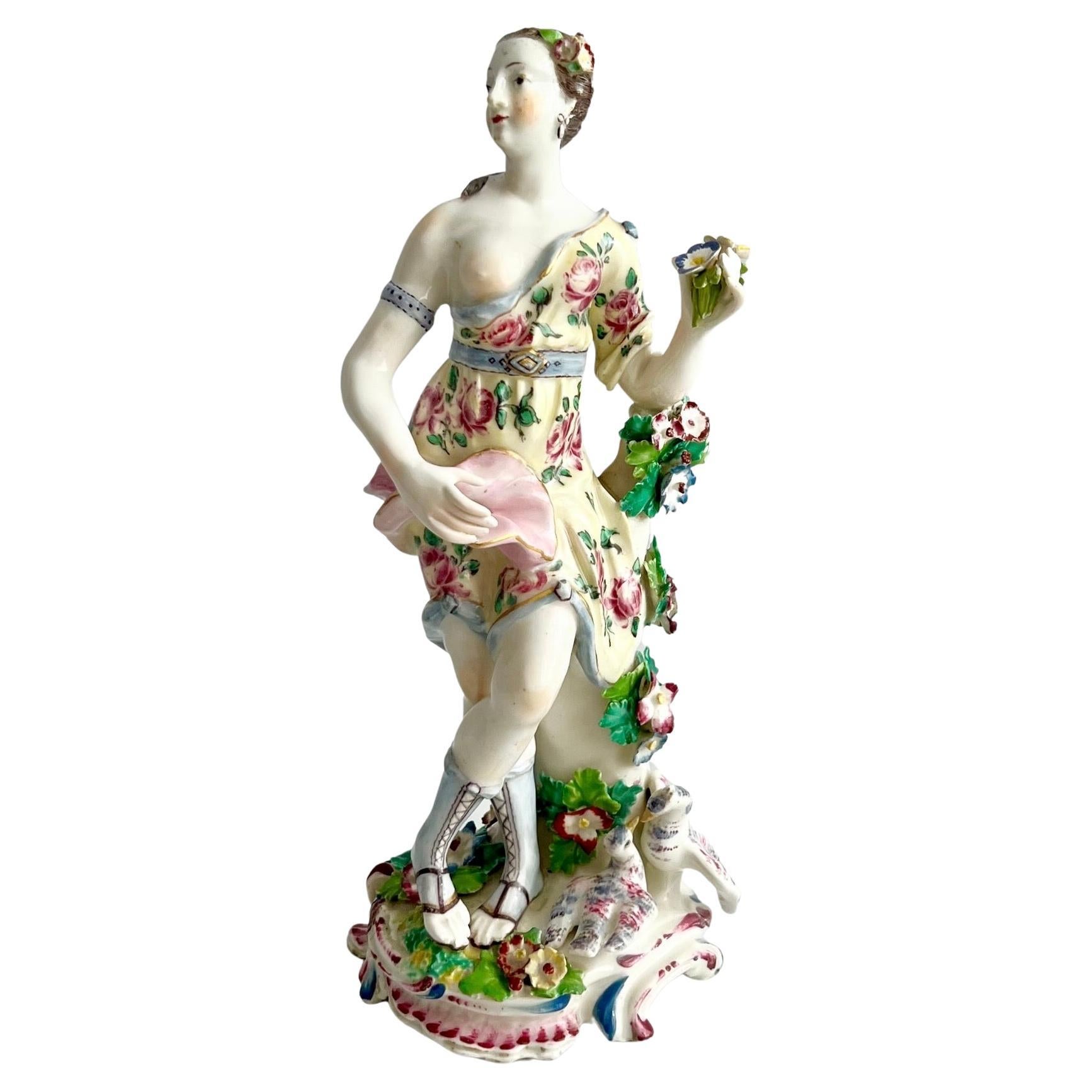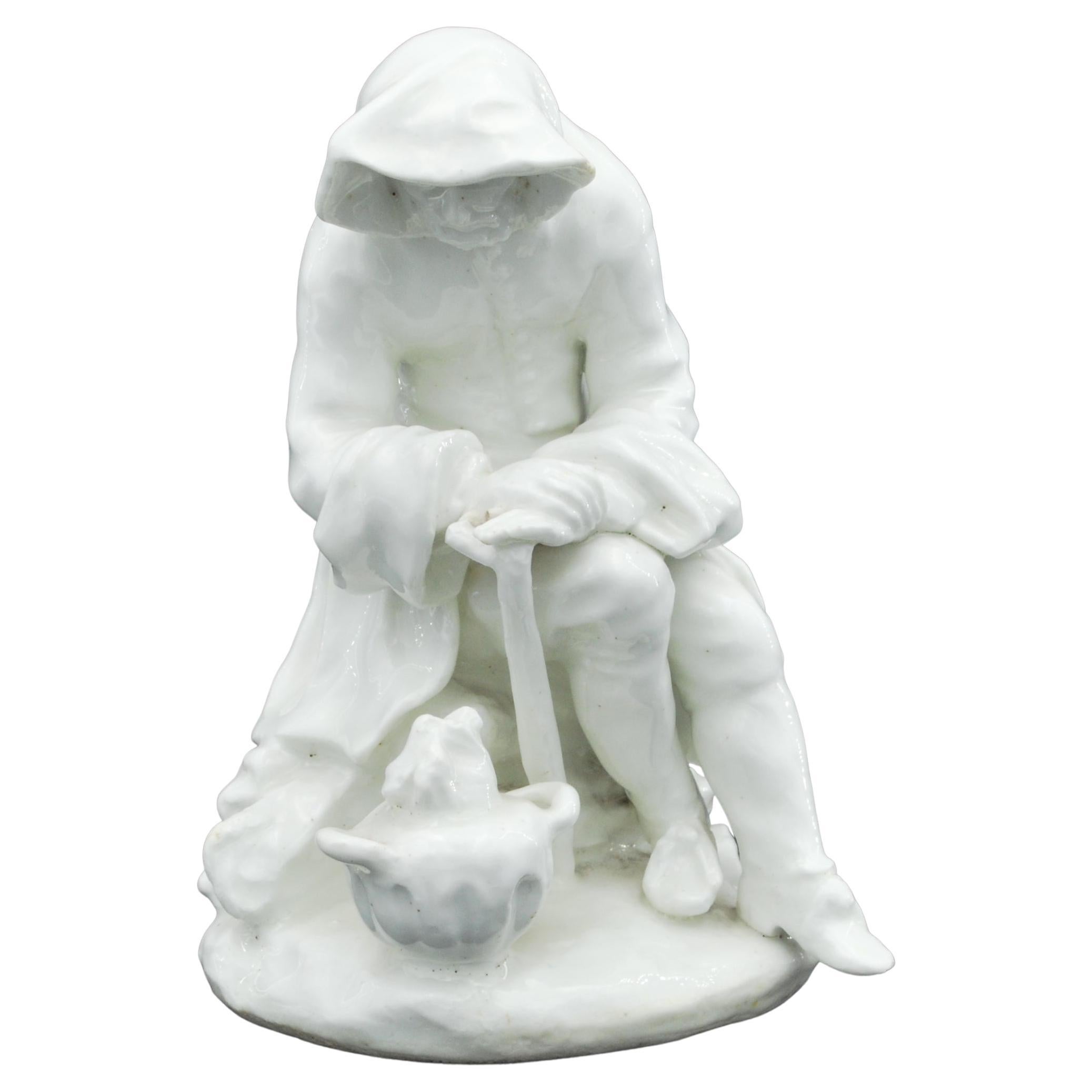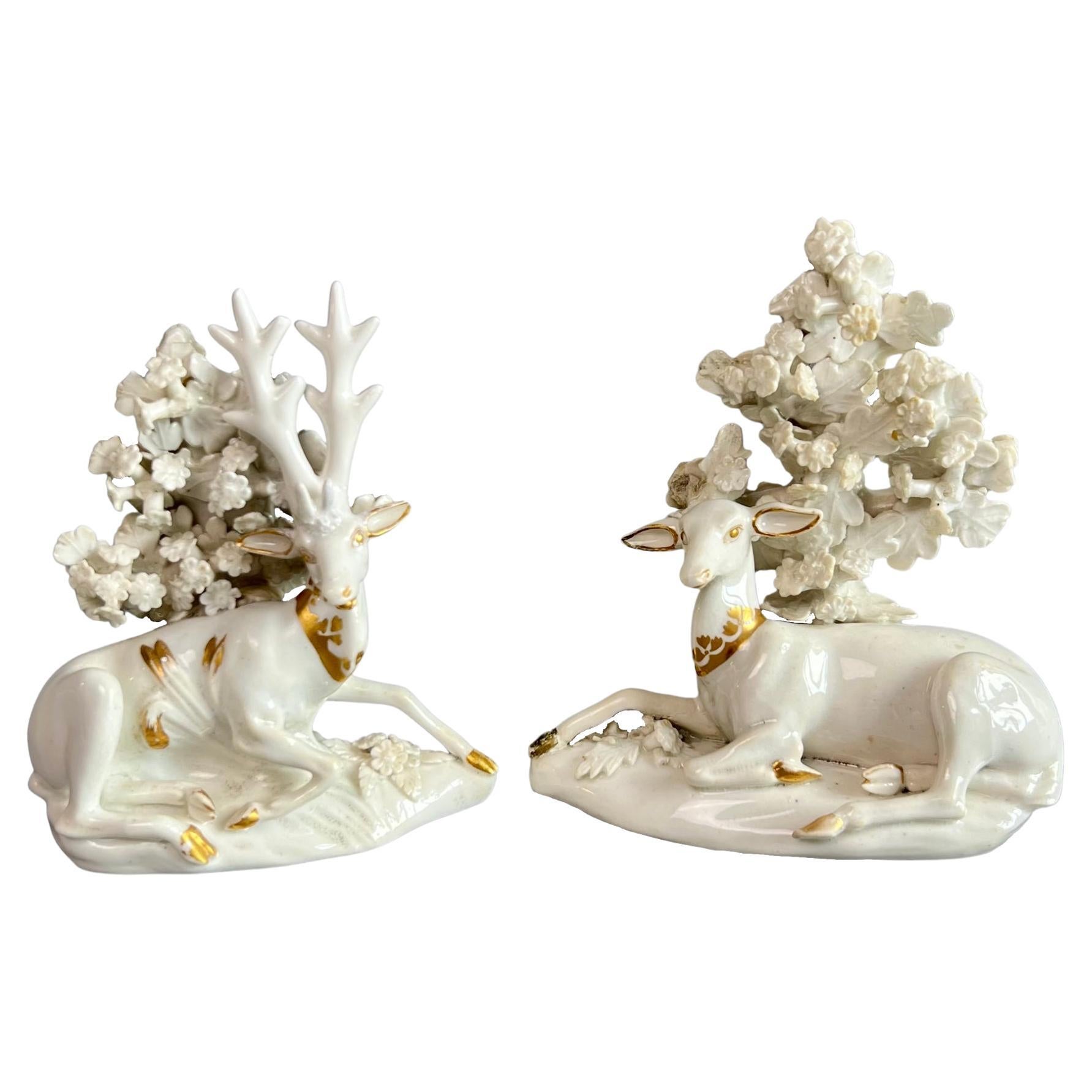Items Similar to Bow Complete Set of Porcelain Figures "The Four Elements", Rococo, circa 1765
Want more images or videos?
Request additional images or videos from the seller
1 of 17
Bow Complete Set of Porcelain Figures "The Four Elements", Rococo, circa 1765
About the Item
This is a very rare and impressive complete set of large figures called The Four Elements, made by the Bow Porcelain factory in about 1765. It consists of Ceres representing Earth, Vulcan representing Fire, Neptune representing Water andJuno representing Air.
The Bow Porcelain Factory was one of the first potteries in Britain to make soft paste porcelain, and most probably the very first to use bone ash, which later got perfected by Josiah Spode to what is now the universally used "bone china". Bow was the main competitor of the Chelsea Porcelain Factory, but where Chelsea made very fine slipcast porcelain, Bow made a different soft paste porcelain that tended to be softer and could be pressed into moulds. Bow served a larger public generally at lower prices. The factory was only in operation between 1743 and 1774, after which the tradition got incorporated into some of the later famous potteries such as Worcester and Derby.
These figures were used to adorn the dinner table when dessert was served; groups of figures served to express something about the host, the guests, or to direct the conversation. A favourite pastime of the period was to guess the nature of Classical gods and goddesses, and thus show off one's erudition.
These figures date from about 1765, which was at the height of Bow's ability to make beautiful figures often copied from Chelsea or Meissen. The porcelain is translucent with a beautiful milky glaze.
These figures are based on sculptures that can be found in the gardens of Versailles.
Ceres is based on "La Terre" by Benoit Massou, which stands at the Parterre du Nord. She holds a cornucopia filled to the brim with fruits and flowers, signifying the Fruits of the Earth; beside her is a large recumbent lion, signifying the Kingdom of Animals.
Vulcan is based on a sculpture called "Le Feu" by Nicolas Dossier, which stands at the Parterre de Latone. Again the female original has been adapted to a male, this time an effeminate youth. We see Vulcan standing by a flaming brazier, warming his hands; at his feet is a phoenix issuing from flames.
Neptune is based on a marble called "L'Eau" by Pierre Legros, which stands at the Fontaine du Point du Jour. But while Legros' sculpture depicts a female, Bow has turned this into the mature, bearded male Neptune, pouring water from an urn. Beside him is a large dolphin in bright colours.
Juno is based on a sculpture called "L'Air" by Étienne le Hongre, which stands at the Parterre d'Eau. We see her waving her garment, signifying air, and at her feet is Jupiter, appropriately in his favourite guise of an eagle. Jupiter is both Juno's husband and twin brother (that's a rather complicated story!) and often appears in disguise.
The figures are not marked, which is quite common for Bow figures. Images of these figures can be found in Peter Bradshaw's book on Bow Porcelain Figures, page 193, plates 203 and 204, with the description on pages 100-101.
All figures are stood on beautiful high Rococo scrolls; three of them are identically coloured in puce and gilt, but Neptune has more blue, suggesting that this set was matched at some point.
Provenance: The John Buckingham Collection.
CONDITION REPORT Some of the figures have some restoration but they overall look stunning. Ceres (Earth) has one restored foot on the base, restoration to the cornucopia, right arm, cape and neck, and some typical small losses to the encrusted flowers. Vulcan (Fire) has some losses to the flames of the phoenix and a few fingers of the left hand missing. Neptune (Water) has no damage other than some tiny losses to his crown of weeds. Juno (Air) is in perfect condition.
The restorations are dated and some of the missing elements such as fingers and flames could be easily added; if desired we can arrange for the restorations to be redone by modern standards, which would make them entirely invisible and we would charge at cost price. Please note that it might take some time to book a slot with one of our approved restorers.
Antique British porcelain is never perfect. Kilns were fired on coal in the 1700s, and this meant that china from that period can have some firing specks from flying particles. British makers were also known for their experimentation, and sometimes this resulted in technically imperfect results. Due to the shrinkage in the kiln, items can have small firing lines or develop crazing over time, which should not be seen as damage but as an imperfection of the maker's recipes, probably unknown at the time of making. Items have often been used for many years and can have normal signs of wear, and gilt can have signs of slight disintegration even if never handled. I will reflect any damage, repairs, obvious stress marks, crazing or heavy wear in the item description but some minor scratches, nicks, stains and gilt disintegration can be normal for vintage items and need to be taken into account.
There is widespread confusion on the internet about the difference between chips and nicks, or hairlines and cracks. I will reflect any damage as truthfully as I can, i.e. a nick is a tiny bit of damage smaller than 1mm and a chip is something you can easily see with the eye; a glazing line is a break in the glazing only; hairline is extremely tight and/or superficial and not picked up by the finger; and a crack is obvious both to the eye and the finger. Etcetera - I try to be as accurate as I can and please feel free to ask questions or request more detailed pictures!
DIMENSIONS 29cm high (11.5").
- Creator:Bow Porcelain (Maker)
- Dimensions:Height: 1 in (2.54 cm)Width: 1 in (2.54 cm)Depth: 1 in (2.54 cm)
- Style:Rococo (Of the Period)
- Materials and Techniques:
- Place of Origin:
- Period:1760-1769
- Date of Manufacture:circa 1765
- Condition:Repaired: various professional repairs, please see description. Wear consistent with age and use. Minor losses. In good antique condition with some restorations and typical small losses.
- Seller Location:London, GB
- Reference Number:
About the Seller
5.0
Gold Seller
These expertly vetted sellers are highly rated and consistently exceed customer expectations.
Established in 2016
1stDibs seller since 2019
208 sales on 1stDibs
Typical response time: 1 hour
- ShippingRetrieving quote...Ships From: London, United Kingdom
- Return PolicyA return for this item may be initiated within 14 days of delivery.
More From This SellerView All
- Bow Porcelain Figure of Juno with Eagle 'Jupiter', Rococo Ca 1765By Bow PorcelainLocated in London, GBThis is a very rare and impressive large figure of Juno with an eagle, made by the Bow Porcelain factory in about 1765. This figure formed part of a series of the Four Elements, with...Category
Antique 1760s English Rococo Figurative Sculptures
MaterialsPorcelain
- Bow Pair of Porcelain Figures of Liberty & Matrimony, Rococo 1760-1764By Bow PorcelainLocated in London, GBThis is a fabulous pair of figures of Liberty and Matrimony made by the Bow Porcelain factory between 1760 and 1764. These figures were a popular pair portraying marriage. The bow...Category
Antique 1760s English Rococo Figurative Sculptures
MaterialsPorcelain
- Bow Pair of Porcelain Figures, Arlecchino and Columbina, Rococo ca 1758By Bow PorcelainLocated in London, GBThis is a wonderful pair of figures of Arlecchino and Columbina, made by the Bow Porcelain factory in about 1758. These figures formed part of a series of the Commedia dell'Arte, a very popular series of theatrical figures that served as decoration at the dinner table in the 18th Century. The Bow Porcelain Factory was one of the first potteries in Britain to make soft paste porcelain, and most probably the very first to use bone ash, which later got perfected by Josiah Spode to what is now the universally used "bone china". Bow was the main competitor of the Chelsea Porcelain Factory, but where Chelsea made very fine slipcast porcelain, Bow made a different soft paste porcelain that tended to be softer and could be pressed into moulds. Bow served a larger public generally at lower prices. The factory was only in operation between 1743 and 1774, after which the tradition got incorporated into some of the later famous potteries such as Worcester and Derby. These figures were used to adorn the dinner table when dessert was served; groups of figures served to express something about the host, the guests, or to direct the conversation. The Italian Commedia Dell'Arte, a comical form of masked theatre, was very popular in those days and Bow copied many figures of the German Meissen series that were brought out in the decades before. This pair dates from about 1758, which was at the height of Bow's ability to make beautiful figurines often copied from Chelsea or Meissen. The pair is modelled after a Meissen pair by Kaendler. The porcelain is translucent with a beautiful milky glaze - Bow was probably the first pottery using bone in its porcelain recipe. Arlecchino (Harlequin) is playing the bagpipes, dressed in an odd costume of mismatched chintz and playing cards and wearing a funny black trumpet...Category
Antique 1750s English Rococo Figurative Sculptures
MaterialsPorcelain
- Bow Porcelain Figure of Venus with Doves, Rococo, 1756-1764By Bow PorcelainLocated in London, GBThis is a rare and beautiful figure of Venus with two doves, made by the bow porcelain factory between 1756 and 1764. We see Venus standing holding her robe with one hand, a flower p...Category
Antique 1760s English Rococo Figurative Sculptures
MaterialsPorcelain
- Bloor Derby Pair of Porcelain Figures, Stag and Doe, circa 1765-1820By Derby, Bloor DerbyLocated in London, GBThis is a very charming pair of porcelain figures of a stag and a doe, probably cast by Derby in about 1760 and decorated by Bloor Derby in 1820. The figures are a simple white porce...Category
Antique 1760s English Rococo Figurative Sculptures
MaterialsPorcelain
- Bow Porcelain Figure of Boy or Putto on C-Scroll Base, Georgian circa 1760By Bow PorcelainLocated in London, GBThis is a wonderful little figure of a boy or putto made by the Bow Porcelain factory in about 1760. The Bow Porcelain Factory was one of the first potteries in Britain to make soft...Category
Antique 1760s English Rococo Figurative Sculptures
MaterialsPorcelain
You May Also Like
- Winter, from the Four Seasons, Bow Porcelain Factory, circa 1750By Bow PorcelainLocated in Melbourne, VictoriaA personification of Winter, from The Four Seasons. Unusually fine condition for a figure of this period.Category
Antique Mid-18th Century English Neoclassical Porcelain
MaterialsPorcelain
- Decorative Basket, Bow Porcelain Factory, circa 1760By Bow PorcelainLocated in Melbourne, VictoriaA pierced basket standing on a well-formed rococo base. Perhaps for potpourri, although the internal decoration suggests another use. We think probably oranges, chestnuts, etc. Pr...Category
Antique Mid-18th Century English Rococo Figurative Sculptures
MaterialsPorcelain
- Figure of The Vintner's Companion, Bow Porcelain Factory, circa 1748By Bow PorcelainLocated in Melbourne, VictoriaMoulded in a dense body in typical muses modeller style and with slightly drab glaze. She stands by a fruiting vinestock and carries an open basket of grapes in her right hand, her e...Category
Antique Mid-18th Century English Neoclassical Figurative Sculptures
MaterialsPorcelain
- Pair of Itinerant Ballad Singer figures. Bow porcelain C1748By Bow PorcelainLocated in Melbourne, VictoriaFlemish man and wife, in the white. He wears an open coat, waistcoat, breeches and tricorn hat, and plays a hurdy-gurdy. She wears a sleeved dress, long apron and linen cap and carri...Category
Antique 1740s English Neoclassical Porcelain
MaterialsPorcelain
- Figure: Running Girl, Bow Porcelain Factory, circa 1756By Bow PorcelainLocated in Melbourne, VictoriaSmall figure of a young woman wearing a puce-sprigged white skirt, lifted slightly with her left hand, pale pink jacket with typical Bow opaque blue collar and cuffs. We've called...Category
Antique Mid-18th Century English Rococo Porcelain
MaterialsPorcelain
- Figure, Mercury, Bow Porcelain, circa 1748By Bow PorcelainLocated in Melbourne, VictoriaHe wears a winged helmet and sandals, a loosely draped pink, white, and yellow washed cloak over a short tunic, and leans arrogantly against bales, his message sack over his left sho...Category
Antique Mid-18th Century English Neoclassical Figurative Sculptures
MaterialsPorcelain
